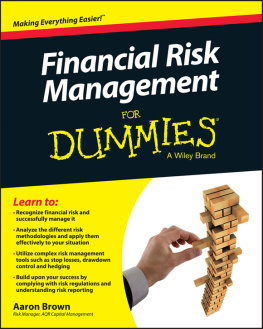
Table of Contents
List of Tables
- Chapter 1
- Chapter 2
- Chapter 3
- Chapter 4
- Chapter 5
- Chapter 6
- Chapter 7
List of Illustrations
- Chapter 1
- Chapter 2
- Chapter 3
- Chapter 4
- Chapter 5
- Chapter 6
- Chapter 7
Guide
Pages
Founded in 1807, John Wiley & Sons is the oldest independent publishing company in the United States. With offices in North America, Europe, Australia, and Asia, Wiley is globally committed to developing and marketing print and electronic products and services for our customers professional and personal knowledge and understanding.
The Wiley Finance series contains books written specifically for finance and investment professionals as well as sophisticated individual investors and their financial advisors. Book topics range from portfolio management to e-commerce, risk management, financial engineering, valuation, and financial instrument analysis, as well as much more.
For a list of available titles, visit our website at www.WileyFinance.com.
Strategic Risk Management
Designing Portfolios and Managing Risk
CAMPBELL R. HARVEY
SANDY RATTRAY
OTTO VAN HEMERT

Copyright 2021 by John Wiley & Sons, Inc. All rights reserved.
Published by John Wiley & Sons, Inc., Hoboken, New Jersey.
Published simultaneously in Canada.
No part of this publication may be reproduced, stored in a retrieval system, or transmitted in any form or by any means, electronic, mechanical, photocopying, recording, scanning, or otherwise, except as permitted under Section 107 or 108 of the 1976 United States Copyright Act, without either the prior written permission of the Publisher, or authorization through payment of the appropriate per-copy fee to the Copyright Clearance Center, Inc., 222 Rosewood Drive, Danvers, MA 01923, (978) 750-8400, fax (978) 646-8600, or on the Web at www.copyright.com. Requests to the Publisher for permission should be addressed to the Permissions Department, John Wiley & Sons, Inc., 111 River Street, Hoboken, NJ 07030, (201) 748-6011, fax (201) 748-6008, or online at http://www.wiley.com/go/permissions.
Limit of Liability/Disclaimer of Warranty: While the publisher and author have used their best efforts in preparing this book, they make no representations or warranties with respect to the accuracy or completeness of the contents of this book and specifically disclaim any implied warranties of merchantability or fitness for a particular purpose. No warranty may be created or extended by sales representatives or written sales materials. The advice and strategies contained herein may not be suitable for your situation. You should consult with a professional where appropriate. Neither the publisher nor author shall be liable for any loss of profit or any other commercial damages, including but not limited to special, incidental, consequential, or other damages.
For general information on our other products and services or for technical support, please contact our Customer Care Department within the United States at (800) 762-2974, outside the United States at (317) 572-3993 or fax (317) 572-4002.
Wiley publishes in a variety of print and electronic formats and by print-on-demand. Some material included with standard print versions of this book may not be included in e-books or in print-on-demand. If this book refers to media such as a CD or DVD that is not included in the version you purchased, you may download this material at http://booksupport.wiley.com. For more information about Wiley products, visit www.wiley.com.
Library of Congress Cataloging-in-Publication Data:
Names: Harvey, Campbell R., author. | Rattray, Sandy, author. | Van Hemert, Otto, author.
Title: Strategic risk management : designing portfolios and managing risk / Campbell R. Harvey, Sandy Rattray, and Otto Van Hemert.
Description: First edition. | Hoboken : Wiley, 2021. | Series: Wiley finance | Includes index.
Identifiers: LCCN 2021005741 (print) | LCCN 2021005742 (ebook) | ISBN 9781119773917 (hardback) | ISBN 9781119773948 (adobe pdf) | ISBN 9781119773924 (epub)
Subjects: LCSH: Portfolio management. | Risk management.
Classification: LCC HG4529.5 .H378 2021 (print) | LCC HG4529.5 (ebook) | DDC 332.6dc23
LC record available at https://lccn.loc.gov/2021005741
LC ebook record available at https://lccn.loc.gov/2021005742
Cover Design: Wiley
Cover Image: Mike Robinson
Proceeds from this book will be donated to The Access Project, which supports students from disadvantaged backgrounds to access top universities through tuition and in-school mentoring. Please visit https://www.theaccessproject.org.uk/ for more information.
Foreword
By Martin Leibowitz
Active funds devote considerable effort to the search for excess returns, but risk considerations often fail to get anywhere near the same level of attention. The authors of this book, Campbell Harvey, Sandy Rattray, and Otto Van Hemert, take risk seriously and give it the consideration it deserves.
Risk considerations can get short shrift in many ways. For example, historical returns typically are reported without reference to the risk taken to achieve them. Unfortunately, without a better understanding of the risk involved, it is difficult to estimate the likelihood that such (possibly fortuitous) returns can be repeated.
In the standard risk management approach, the focus is on setting volatility constraints associated with various targets and benchmarks. Such constraints often are based on the probability of a significant downdraft that could adversely impact the current investment strategy. In actuality, the commonality of such constraints across a wide range of funds suggests that some peer group pressure might also be at play.
Once risk limits have been established, managers generally are permitted to roam relatively freely in the search for higher returns. Risk considerations are then relegated to ensuring that returns stay within the pre-established bounds. In effect, this approach tends to put risk assessment in a box that is removed from day-to-day fund management.
In the asset allocation context, this fence-posting behavior is built on the belief that the maximum expected return is equivalent to the optimal return. However, that may not be the case when the funds true objectives are considered.
This books authors make the case that the position of a fund relative to its risk boundaries should be integrated into any consideration of investment shifts. The challenge is garnering sufficient incremental return from new investments to justify all incremental risks.
In theory, each incremental investment initiative or allocation shift should be based on a holistic risk/return valuation. This valuation should include an understanding of the interaction between marginal investment changes and the probability of success relative to various absolute and/or market-sensitive performance goals. An absolute goal might be to achieve a specific return or some given level of spending. Market-sensitive goals might include a desired probability that the funds performance will exceed that of a peer group, market benchmark, or customized reference portfolio.
When such market-sensitive targets are considered, correlations between investment and target returns become important. The incremental return advantage versus a moving target will be improved if the portfolio and the target are closely aligned along the primary dimension of risk.
Next page







